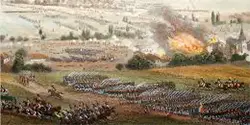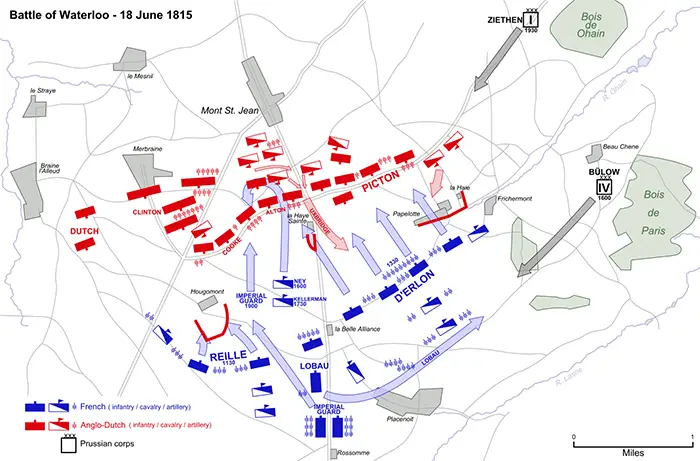The Battle of Waterloo
Part 1: The Prelude The Battle of Waterloo was the last defeat suffered by French Emperor Napoleon Bonaparte. The battle, which took place on June 18, 1815, ended his decadeslong struggle to the reach of France and its Revolution far beyond the country's original borders. After suffering defeat in the War of the Sixth Coalition, Bonaparte had abdicated his throne, had surrendered to Coalition forces, and had been exiled to the island of Elba. All of that took place in the spring of 1814. Bonaparte had arrived on Elba on May 14, 1814, a little more than a month after he had abdicated the French imperial throne. While in exile, he kept abreast of the goings-on in Europe. He knew that France again had a king, Louis XVIII. He knew that the leaders of Europe were negotiating at the Congress of Vienna. He didn't like what he found out. As time went on, the alliance that had coalesced into resistance to the French Empire in the person of Napoleon fragmented, as competing desires led to differences of opinion in how to carry on with relation to one another. The remaining powers disagreed on how to proceed with regard to Poland and with Saxony and other German states. Austria wanted northern Italy. The strength of Russia scared and intimidated rulers in Western Europe. Closer to home, the people of France were not all that happy with another king (even though they had had an emperor serving over them for a few years). Also filtering through On Feb. 25, 1815, a flotilla of six ships sailed from Elba. On one of those ships, the Inconstant, was Bonaparte, along with a group of loyal soldiers who had been with him on the island. They reached France on March 1. Bonaparte and his small force, which was small only in relative terms and was in reality about 1,000, put ashore near Cannes and marched toward Paris. Thus began the Hundred Days. King Louis XVIII had left Paris on March 13, and Bonaparte and his men arrived the following week. They had faced not a single shot fired in anger. By that time, the Congress of Vienna had declared Napoleon an outlaw. On March 25, a familiar group of countries signed the Treaty of Alliance; following that was the War of the Seventh Coalition. 
The Allies had set a date of July 1 for an invasion of France. The gap between the declaration of war and the first major Allied action was to give Austria and Russia enough time to mobilize their forces sufficiently. As well, a large part of the U.K. force had been sent to North America, to fight in the War of 1812. Bonaparte chose not to wait, crossing the border at Charleroi on June 15 and, the following day, attacking the Prussian force at Ligny while Marshal Michel Ney engaged the U.K. forces at Quatre Bas. The former was a French victory; the latter was nondecisive. The Allied force at Quatre Bas withdrew to Waterloo, in what is now Belgium, with little harassment from Ney and the French. The commander of that force was Arthur Wellesley, known as the Duke of Wellington. He had had great success at defeating French armies in Portugal and Spain during the Peninsular War. The French plan was to keep the Prussian and U.K. forces divided. Bonaparte knew that his army slightly outnumbered Wellington's but that the Prussian force, under Field Marshal Gebhard von Blücher, was about 50,000 and wasn't far away. They had retreated from Ligny but, instead of heading eastward toward more Prussian troops, had headed northward, in an attempt to keep in contact with Wellington. French armies had defeated Blücher and had fought Wellington to a standstill yet had, in both cases, allowed the enemy to depart with impunity. On June 17, Bonaparte sent Marshal Emmanuel de Grouchy and 33,000 men to ensure that the Prussians were kept occupied. That left Bonaparte with 72,000 men (48,000 infantry, 14,000 cavalry, 7,000 artillery) and 250 guns. Wellington had 69,000 men (50,000 infantry, 11,000 cavalry, 6,000 artillery) and 150 guns. On that same day, a torrential thunderstorm doused the area, leaving behind a morass of mud. The French army had marched in the rain pursuit of Wellington and then slept in the open on wet ground. Wellington had forces from other powers under his command. With him were troops from Brunswick, Hanover, Nassau, and the Netherlands. Their collective experience was much less than what France could bring to bear. Retreating from Quatre Bas, the Allied force had formed up around the low ridge of Mont-Saint-Jean, which was south of the town of Waterloo. Wellington, an expert at defensive positioning and fortifications, was familiar with the area, having traveled through it the year before. He made good use of a deep sunken lane and the reverse slope to conceal the placement of the Allied forces. On the Allied right, near the front, was Hougoumont, a cháteau that consisted of a garden, an orchard, and a well built country house that lent itself to being well defended, supported as it was by a sunken covered lane and by 1,200 well trained troops. The Allied line stretched to the left to the village of Papelotte, from which a road ran to Wavre, from whence the Prussian reinforcements would come. Another prominent position was La Haye Sainte, a farmhouse and orchard; defending that were a few hundred light infantry.  Next page > The Battle and Aftermath > Page 1, 2 |
|
Social Studies for Kids
copyright 2002–2024
David White



 were reports of the new French government's treating the people poorly. All of this was known to Napoleon, and knowing all of this, coupled with his desire to still make a difference in the world, compelled him to escape his island exile.
were reports of the new French government's treating the people poorly. All of this was known to Napoleon, and knowing all of this, coupled with his desire to still make a difference in the world, compelled him to escape his island exile.
